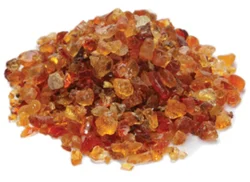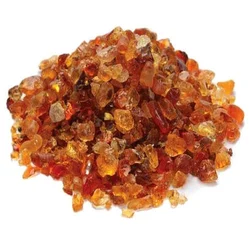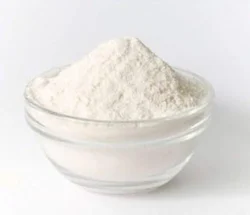Arabic gum
Synonym(s):Acacia gum
- CAS NO.:9000-01-5
- Empirical Formula: N/A
- Molecular Weight: 0
- MDL number: MFCD00081264
- EINECS: 232-519-5
- Update Date: 2025-12-25 11:31:46
What is Arabic gum?
Description
Acacia gum is an odourless white to yellow-white powder. It is soluble in water and incompatible with alcohol and oxidising agents and precipitates. It gels on addition of solutions of ferric salts, borax, lead subacetate, alcohol, sodium silicate, gelatin, and ammoniated tincture of guaiac. It is non-toxic and non-hazardous. It is a water-soluble gum from several species of the acacia tree, especially Acacia senegal and A. arabica, and used in the manufacture of adhesives and ink and as a binding medium for marbling colours. Gum arabic is also known as gum acacia and is a natural gum made of hardened sap taken from two species of the Acacia tree – Acacia senegal and Acacia seyal. Gum arabic is a natural product of the Acacia senegal tree, occurring as an exudate from the trunks and branches. It is used primarily in the food industry as a stabiliser but has had more varied uses. It is normally collected by hand when dried, when it resembles a hard, amber-like resin normally referred to as ‘tears’. Gum arabic is widely used in the food industry as an emulsifier, thickener, and flavouring and thickening agent. It is employed as a soothing agent in inflammatory conditions of the respiratory, digestive, and urinary tracts and is useful in diarrhoea and dysentery. It exerts a soothing influence upon all the surfaces with which it comes in contact. Gum acacia is an ingredient of all the official Trochisci and various syrups, pastes, and pastilles or jujubes. During the time of the gum harvest, the Moors of the desert are said to live almost entirely on it, and it has been proved that 6 oz. is sufficient to support an adult for 24 h. Gum acacia is highly nutritious, is a mixture of saccharides and glycoproteins, and provides the properties of a glue and binder suitable for human edibility. In many cases of disease, it is considered that a solution of gum arabic may for a time constitute the exclusive drink and food of the patient. Gum arabic reduces the surface tension of liquids, which leads to increased fizzing in carbonated drinks.
Chemical properties
white to yellow-white powder
Chemical properties
Acacia gum is a white to yellow-white odorless powder. It is soluble in water and incom- patible with alcohol, oxidizing agents, and precipitates or forms jellies on addition of solutions of ferric salts, borax, lead subacetate, alcohol, sodium silicate, gelatin, ammoni- ated tincture of guaiac. It is non-toxic and non-hazardous. A water-soluble gum from several species of the acacia tree, especially Acacia senegal and A. Arabica , it is used in the manufacture of adhesives and ink, and as a binding medium for marbling colors. Gum arabic, also known as gum acacia, chaar gund, or char goond, is a natural gum made of hardened sap taken from two species of the acacia tree— A. senegal and A. seyal . Gum arabic is a natural product of the A. senegal tree, occurring as an exudate from the trunks and branches. It is used primarily in the food industry as a stabilizer, but has had more varied uses. It is normally collected by hand when dried, when it resembles a hard, amber-like resin normally referred to as “tears.” Gum arabic is widely used in the food industry, as an emulsifi er, thickener, and fl avor enhancer. It is employed as a soothing agent in infl ammatory conditions of the respiratory, digestive, and urinary tract, and is useful in diarrhea and dysentery. It exerts a soothing infl uence on all the surfaces with which it comes in contact. Gum acacia is an ingredient of all the offi cial Trochisci, and various syrups, pastes, and pastilles or jujubes. During the time of the gum harvest, the Moors of the desert are said to live almost entirely on it, and it has been proved that 6 oz is suffi cient to support an adult for 24 h. Gum acacia is a mixture of saccharides and glycoproteins, is highly nutritious, and provides the properties of a glue, and a binder suitable for human consumption. In many cases of disease, it is considered that a solu- tion of gum arabic may, for a time,constitute the exclusive drink and food of the patient. Gum arabic reduces the surface tension of liquids, which leads to increased fi zzing in carbonated drinks.
Chemical properties
Acacia is available as white or yellowish-white thin flakes, spheroidal tears, granules, powder, or spray-dried powder. It is odorless and has a bland taste.
Chemical properties
Arabic.or.acacia.gum.is.the.dried.exudate.obtained.from.the.stems.and.branches.of.Acacia senegal (L.).Willd.or.of. related.species.of.Acacia..Injured.trees.exude.gum.Arabic;.heat,.poor.nutrition.and.drought.stimulate.its.production..Most.of.the.gum. Arabic.production.is.from.wild.trees,.but.some.from.privately.owned.and.cultivated.gardens.are.tapped.and.collected.on.a.systematic. basis.
The.gum.called.Hashab.geneina.(garden.gum).is.the.cleanest.and.lightest.grade.and.is.most.preferred.for.the.U.S..market..The.wild. gum.(called.Hashab.wady).is.collected.on.a.part-time.basis.in.the.dry.season,.from.October.to.May.or.June,.by.natives.whose.main. occupation.is.usually.farming..After.gathering,.it.is.taken.to.central.collecting.stations.where.it.is.auctioned.under.government.supervision,.graded.by.hand.and.dried.before.exporting.to.gum.suppliers.in.all.parts.of.the.world..Then.it.is.resorted,.ground,.processed. and.graded.to.various.specifications
Clear,.white.(sun-bleached).spheroidal.tears,.up.to.32.mm.in.diameter,.also.occur.as.flakes..Chemically,.gum.Arabic.is.a.neutral.or. slightly.acid.salt.of.a.complex.polysaccharide.containing.calcium,.magnesium.and.potassium.cations..Its.most.distinguishing.property.among.the.natural.gums.is.its.extreme.solubility.in.water..Solutions.of.over.50%.concentration.may.be.prepared..Gum.Arabic. is.best.described.as.“heteropolymolecular,”.that.is,.a.polymer.system.having.either.a.variation.in.monomer.(galactose,.arabinose,. rhamnose,.glucuronic.acid.and.4-O-methylgucuronic.acid).composition.and/or.variation.in.the.mode.of.linking.and.branching.of.the. monomer.units,.in.addition.to.a.distribution.in.molecular.weight.
Major.uses.of.gum.Arabic.in.foods.are.as.a.fixative.for.flavors,.a.foam.stabilizer.in.beverages,.an.adhesive.for.icings.and.toppings,. and.an.emulsifier.and.stabilizer.in.confectionary.and.ice.cream.It.is.also.widely.used.in.the.pharmaceutical,.cosmetic,.paper,.textile,. paint,ink.and.lithography.industries.
The Uses of Arabic gum
As mucilage, excipient for tablets, size, emulsifier, thickener, also in candy, other foods; as colloidal stabilizer. In the manufacture of spray-dried "fixed" flavorsstable, powdered flavors used in packaged dry-mix products (puddings, desserts, cake mixes) where flavor stability and long shelf life are important.
The Uses of Arabic gum
acacia (Acacia senegal)(acacia gum; black catechu; gum acacia; gum Arabic) is commonly used in traditional remedies as a soothing and anti-inflammatory agent. It is also used as a vegetable gum for product thickening. In extract form, acacia is recommended for dry, sensitive, or delicate skin. Acacia is the dried gummy sap from the stems and branches of various species of the African acacia tree. It may cause skin rashes in cases of allergy.
The Uses of Arabic gum
A gum obtained from breaks or wounds in the bark of acacia trees. It dissolves in hot or cold water forming clear solutions which can be up to 50% gum acacia. The solubility in water increases with temperature. It is used in confectionary glazes to retard or prevent sugar crystallization and acts as an emulsifier to prevent fat from forming an oxidizable, greasy film. It functions as a flavor fixative in spray-drying to form a thin film around the flavor particle. It also functions as an emulsifier in flavor emulsions, as a cloud agent in beverages, and as a form stabilizer. It is also termed acacia.
What are the applications of Application
Gum arabic is a branched polymer of galactose, rhamnose, arabinose, and glucuronic acid
Definition
The dried, water-soluble exudate from the stems of Acacia senegal or related species.
Production Methods
Acacia is the dried gummy exudate obtained from the stems and
branches of Acacia senegal (Linné ) Willdenow or other related
species of Acacia (Fam. Leguminosae) that grow mainly in the
Sudan and Senegal regions of Africa.
The bark of the tree is incised and the exudate allowed to dry on
the bark. The dried exudate is then collected, processed to remove
bark, sand, and other particulate matter, and graded. Various acacia
grades differing in particle size and other physical properties are
thus obtained. A spray-dried powder is also commercially available.
Taste threshold values
Absolute;.taste.characteristics.at.15.ppm:.spicy.sweet,.fruity.and.honey.with.a.woody,.herbal.nuance
General Description
White powder.
Air & Water Reactions
Water soluble. Aqueous solution is acid to litmus.
Reactivity Profile
Arabic gum reacts with strong oxidizing agents. Arabic gum precipitates out of solution or jellies upon addition of solutions of ferric salts, borax, basic lead acetate, alcohol, sodium silicate, gelatin or ammoniated tincture of guaiac.
Health Hazard
Exposures to gum arabica dust produce a weak allergen reaction. Prolonged periods of dust inhalation may cause allergic respiratory reaction, headache, coughing, dizziness, dyspnea, respiratory symptoms such as asthma, watery nose and eyes, cough, wheezing, nausea, vomiting, dyspnea, and urticaria. Hives, eczema, and swelling may also occur. Ingestion and inhalation of gum acacia is considered non-toxic, but sensitive individuals may develop symptoms of mild toxicity.
Fire Hazard
Flash point data for Arabic gum are not available; however, Arabic gum is probably combustible.
Pharmaceutical Applications
Acacia is mainly used in oral and topical pharmaceutical formulations
as a suspending and emulsifying agent, often in combination
with tragacanth. It is also used in the preparation of pastilles and
lozenges, and as a tablet binder, although if used incautiously it can
produce tablets with a prolonged disintegration time. Acacia has
also been evaluated as a bioadhesive; and has been used in novel
tablet formulations,and modified release tablets.
Acacia is also used in cosmetics, confectionery, food products,
and spray-dried flavors.
Biochem/physiol Actions
Gum arabic (GA) is reported to be a strong anti-oxidant and has shown protection against nephrotoxicity in mice by the generation of free radicals. GA also reduced the blood glucose concentration by initiating the release of insulin from the pancreatic β cells. It has hypolipidemic effect by increasing fecal bile acid and modification of lipid digestion. It is a potential therapeutic agent in hepatic and renal failures. It contains enzymes like oxidases, pectinases and peroxidases that act against microbes that cause tooth decay. Gum arabic is implicated in adverse effects like suppression of macrophage activation.
Safety Profile
Very low toxicity by ingestion.Inhalation or ingestion has produced hives, eczema, andangiodema. Experimental reproductive effects. A severeeye irritant. A weak allergen. Mutation data reported.Combustible. When heated to decomposition it emitsacrid
Safety
Acacia is used in cosmetics, foods, and oral and topical
pharmaceutical formulations. Although it is generally regarded as
an essentially nontoxic material, there have been a limited number
of reports of hypersensitivity to acacia after inhalation or
ingestion.Severe anaphylactic reactions have occurred following
the parenteral administration of acacia and it is now no longer
used for this purpose.
The WHO has not set an acceptable daily intake for acacia as a
food additive because the levels necessary to achieve a desired effect
were not considered to represent a hazard to health.
LD50 (hamster, oral): >18 g/kg
LD50 (mouse, oral): >16 g/kg
LD50 (rabbit, oral): 8.0 g/kg
LD50 (rat, oral): >16 g/kg
Storage
Aqueous solutions are subject to bacterial or enzymatic degradation but may be preserved by initially boiling the solution for a short time to inactivate any enzymes present; microwave irradiation can also be used. Aqueous solutions may also be preserved by the addition of an antimicrobial preservative such as 0.1% w/v benzoic acid, 0.1% w/v sodium benzoate, or a mixture of 0.17% w/v methylparaben and 0.03% propylparaben. Powdered acacia should be stored in an airtight container in a cool, dry place.
Incompatibilities
amidopyrine, apomorphine, cresol, ethanol (95%), ferric salts,
morphine, phenol, physostigmine, tannins, thymol, and vanillin.
An oxidizing enzyme present in acacia may affect preparations
containing easily oxidizable substances. However, the enzyme may
be inactivated by heating at 100℃ for a short time.
Many salts reduce the viscosity of aqueous acacia solutions,
while trivalent salts may initiate coagulation. Aqueous solutions
carry a negative charge and will form coacervates with gelatin and
other substances. In the preparation of emulsions, solutions of
acacia are incompatible with soaps.
Regulatory Status
GRAS listed. Accepted for use in Europe as a food additive. Included in the FDA Inactive Ingredients Database (oral preparations and buccal or sublingual tablets). Included in the Canadian List of Acceptable Non-medicinal Ingredients. Included in nonparenteral medicines licensed in the UK.
Properties of Arabic gum
| Density | 1.35 |
| FEMA | 2001 | ACACIA GUM (ACACIA SENEGAL (L.) WILLD.) |
| storage temp. | Sealed in dry,Room Temperature |
| solubility | water: soluble |
| form | fine powder |
| color | White to yellow-beige |
| Specific Gravity | 1.35-1.49 |
| PH Range | 4.1 - 4.8 |
| Odor | ylsh.-wh. angular fragments, odorless |
| Water Solubility | Water soluble. Aqueous solution is acidic to litmus. |
| Merck | 14,14 |
| Stability: | Stable. Incompatible with alcohols, oxidizing agents. |
| CAS DataBase Reference | 9000-01-5 |
| EPA Substance Registry System | Gum arabic (9000-01-5) |
Safety information for Arabic gum
| Pictogram(s) |
 Exclamation Mark Irritant GHS07 |
| GHS Hazard Statements |
H315:Skin corrosion/irritation H319:Serious eye damage/eye irritation H335:Specific target organ toxicity, single exposure;Respiratory tract irritation |
| Precautionary Statement Codes |
P261:Avoid breathing dust/fume/gas/mist/vapours/spray. P304+P340:IF INHALED: Remove victim to fresh air and Keep at rest in a position comfortable for breathing. P305+P351+P338:IF IN EYES: Rinse cautiously with water for several minutes. Remove contact lenses, if present and easy to do. Continuerinsing. P405:Store locked up. |
Computed Descriptors for Arabic gum
Arabic gum manufacturer
New Products
4,4-Difluoropiperidine hydrochloride tert-butyl 9-methoxy-3-azaspiro[5.5]undecane-3-carboxylate Indole Methyl Resin N-Isopropylurea N,N-Dicyclohexylcarbodiimide(DCC) MELDRUMS ACID 5-METHYLISOXAZOLE-4-CARBOXYLIC ACID Magnessium Bis glycinate Zinc ascorbate 1-bromo-2-butyne 2-acetamidophenol 9(10H)-anthracenone Erythrosin B, 4-Piperidinopiperidine 2-((4-morpholinophenylamino) (methylthio) methylene) malononitrile 2,4-dihydroxybenzaldehyde 3-(4-morpholinophenylamino)-5-amino-1H-pyrazole-4-carbonitrile Methyl 2-methylquinoline-6-carboxylate 2,6-dichloro-4-nitropyridine 4-Bromo-2-chlorobenzonitrile 2-(benzylamino)acetic acid hydrochloride 4-(tert-Butoxycarbonylamino)but- 2-ynoic acid 3,4-dihydro-2H-benzo[b][1,4]dioxepine 1-Phenyl-1-cycloprppanecarboxylicacidRelated products of tetrahydrofuran








You may like
-
 Acacia, Total ash <4% CAS 9000-01-5View Details
Acacia, Total ash <4% CAS 9000-01-5View Details
9000-01-5 -
 Acacia, Total ash <4% CAS 9000-01-5View Details
Acacia, Total ash <4% CAS 9000-01-5View Details
9000-01-5 -
 Acacia (Gum Acacia) extrapure CAS 9000-01-5View Details
Acacia (Gum Acacia) extrapure CAS 9000-01-5View Details
9000-01-5 -
 Acacia (Gum Acacia) (enzyme free) extrapure AR CAS 9000-01-5View Details
Acacia (Gum Acacia) (enzyme free) extrapure AR CAS 9000-01-5View Details
9000-01-5 -
 ACACIA Extra Pure CASView Details
ACACIA Extra Pure CASView Details -
 Crystal Food Grade Gum Arabic, HDPE BagView Details
Crystal Food Grade Gum Arabic, HDPE BagView Details
9000-01-5 -
 Gum Arabic, 50KgView Details
Gum Arabic, 50KgView Details
9000-01-5 -
 Gum Acacia PowderView Details
Gum Acacia PowderView Details
9000-01-5
